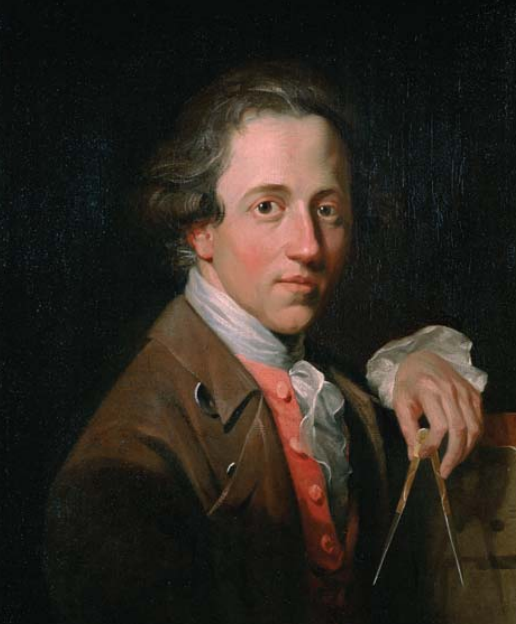Translation by Francesco Mazzaferro
CLICK HERE FOR ITALIAN VERSION
CLICK HERE FOR ITALIAN VERSION
Riccardo de Martino
L'utopia di Soane
Le dodici lezioni di architettura per la Royal Academy di Londra
[Soane's Utopia. The Twelve Lessons of Architecture for the Royal Academy of London]
[Soane's Utopia. The Twelve Lessons of Architecture for the Royal Academy of London]
Naples, Arte Tipografica Editrice, 2006
 |
| Christopher William Hunneman, Portrait of John Soane, 1776. London, Sir John Soane's Museum |
[1] Text of the back cover:
"Sir John Soane (1753-1837), English architect who authored extraordinary buildings - including that of the Bank of England - was a professor of architecture at the Royal Academy in London from 1809 onwards and elaborated the Lectures on Architecture in the context of that intense teaching activity.
The twelve conferences, which constituted a real course in architecture, were intended – in line with the rules of the Royal Academy - "to shape the taste of the students, to make them interested to the laws and principles of composition, in order to make sure they would point out beauties or errors of famous constructions, and to train them to study without the bias which are contained in books and with a critical examination of the structures."
Soane, who was a cultivated and up-to-date interpreter of the architectural culture of his time, and was fully aware of the high responsibility entrusted to him, tried to offer an education that included the history of architecture, the elements of design, but also the technological and structural aspects of the building activity.
This ambitious educational project led Soane to produce - as it has been authoritatively stated by critics - "the most comprehensive and illuminating discussion of the history and theory of architecture available in the early nineteenth century."
The publication of the first critical edition of the Lectures in Italian not only offers a more complete description of Soane’s personality, as an extraordinary interpreter of European architecture between the eighteenth and nineteenth centuries, but also helps us understand the dissemination and the features of a common architectural culture across Europe in this crucial phase. At that time, in fact, the need for dissemination of a modern knowledge in this field, gave birth to institutions, schools and academies, which would form many of the architects of the next generation.
Soane’s lessons were the first systematic attempt to educate architects in a technical and professional manner, beyond the customary artistic or handicraft practice. They are therefore emblematic of a phase of rapid social and economic changes, where technological and industrial progress imposed the emergence of new professions or changed their role, and gave rise to a reflection and a reworking of the old traditional architectural language in the light of new requirements.
This integral edition of the Lectures, complemented by a comprehensive bio-bibliographical apparatus, therefore offers an additional and exciting opportunity to compare and examine the relations among and the differences between Europe’s cultures, and also to highlight the international nature of many of the experiences in the nineteenth century, especially in light of the analysis of Soane’s personality, a British architect who was trained in an Italian tradition."
 |
| Bank of England Entrance Facade 1818-1827 |
[2] On the back cover of this book, the work is described as a critical edition of the Lectures. To be correct, it "merely" offers the complete translation in Italian, without any English text.
[3] The editor noted that the key core of the Lessons is that consisting of the first six ones, dating back to 1810, 1812, 1813, 1817 and 1819 respectively (it is obvious that two were held in the same year, but the editor does not tell us which one), while the following lessons were all kept in 1815. The fact that the Lectures do not comply with a strict chronological order shows that they were revised and rearranged over the years, not only for the purpose of more effective teaching (note however that Soane’s lessons were held on his behalf by Henry Howard since 1820, since the English architect had withdrawn from teaching, citing health reasons and excessive work commitments), but perhaps also to be published. Actually, the publication of the Lectures took place over one hundred years later, and was edited by A.T. Bolton (Lectures on Architecture by Sir John Soane. As delivered to students of the Royal Academy from 1809 to 1836, London, 1929).
 |
| Holy Trinity Church, Marylebone, 1824-1826, London |
[4] On the contents of the lectures by Soane see pp. 20-31. We are signalling in particular page 10, because you will find there two rather unusual issues for the Italian architectural theory, but much more common in the English one: on the one hand the architecture of the gardens and on the other one the role of urban design in the overall organization of a town (or cities like London).
 |
| The Sarcophagus Room of the Soane's Museum (1864) |
 |
| Sir John Soane's Museum. The Dome |
[5] We must recall here the Sir John Soane’s Museum, a beautiful museum you can visit in London. It was Soane’s house where he collected a wealth of absolutely different art-pieces. The web-address of the museum is http://www.soane.org/. John Soane also built up an incredible library with very rare manuscripts now at the British Library.

Nessun commento:
Posta un commento